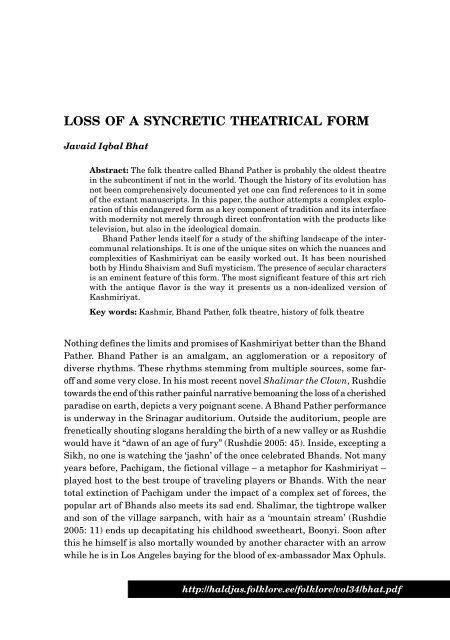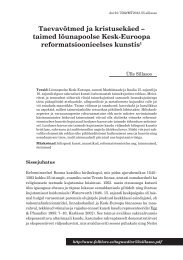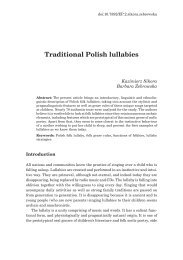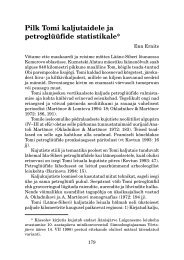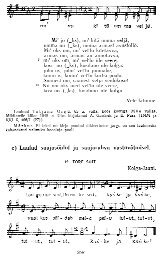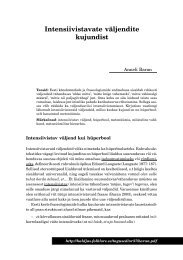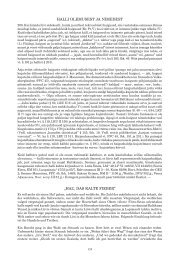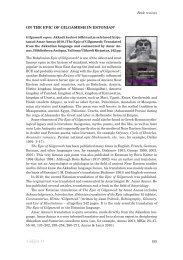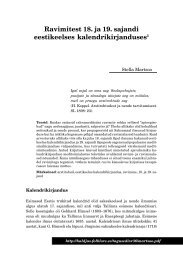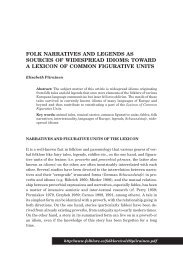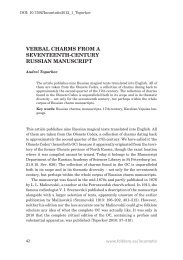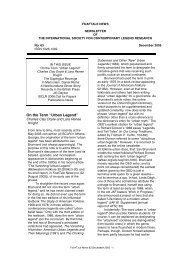LOSS OF A SYNCRETIC THEATRICAL FORM
LOSS OF A SYNCRETIC THEATRICAL FORM
LOSS OF A SYNCRETIC THEATRICAL FORM
You also want an ePaper? Increase the reach of your titles
YUMPU automatically turns print PDFs into web optimized ePapers that Google loves.
<strong>LOSS</strong> <strong>OF</strong> A <strong>SYNCRETIC</strong> <strong>THEATRICAL</strong> <strong>FORM</strong><br />
Javaid Iqbal Bhat<br />
Abstract: The folk theatre called Bhand Pather is probably the oldest theatre<br />
in the subcontinent if not in the world. Though the history of its evolution has<br />
not been comprehensively documented yet one can find references to it in some<br />
of the extant manuscripts. In this paper, the author attempts a complex exploration<br />
of this endangered form as a key component of tradition and its interface<br />
with modernity not merely through direct confrontation with the products like<br />
television, but also in the ideological domain.<br />
Bhand Pather lends itself for a study of the shifting landscape of the intercommunal<br />
relationships. It is one of the unique sites on which the nuances and<br />
complexities of Kashmiriyat can be easily worked out. It has been nourished<br />
both by Hindu Shaivism and Sufi mysticism. The presence of secular characters<br />
is an eminent feature of this form. The most significant feature of this art rich<br />
with the antique flavor is the way it presents us a non-idealized version of<br />
Kashmiriyat.<br />
Key words: Kashmir, Bhand Pather, folk theatre, history of folk theatre<br />
Nothing defines the limits and promises of Kashmiriyat better than the Bhand<br />
Pather. Bhand Pather is an amalgam, an agglomeration or a repository of<br />
diverse rhythms. These rhythms stemming from multiple sources, some faroff<br />
and some very close. In his most recent novel Shalimar the Clown, Rushdie<br />
towards the end of this rather painful narrative bemoaning the loss of a cherished<br />
paradise on earth, depicts a very poignant scene. A Bhand Pather performance<br />
is underway in the Srinagar auditorium. Outside the auditorium, people are<br />
frenetically shouting slogans heralding the birth of a new valley or as Rushdie<br />
would have it “dawn of an age of fury” (Rushdie 2005: 45). Inside, excepting a<br />
Sikh, no one is watching the ‘jashn’ of the once celebrated Bhands. Not many<br />
years before, Pachigam, the fictional village – a metaphor for Kashmiriyat –<br />
played host to the best troupe of traveling players or Bhands. With the near<br />
total extinction of Pachigam under the impact of a complex set of forces, the<br />
popular art of Bhands also meets its sad end. Shalimar, the tightrope walker<br />
and son of the village sarpanch, with hair as a ‘mountain stream’ (Rushdie<br />
2005: 11) ends up decapitating his childhood sweetheart, Boonyi. Soon after<br />
this he himself is also mortally wounded by another character with an arrow<br />
while he is in Los Angeles baying for the blood of ex-ambassador Max Ophuls.<br />
http://haldjas.folklore.ee/folklore/vol34/bhat.pdf<br />
Folklore Folklore 34 34<br />
39
Javaid Iqbal Bhat<br />
Shalimar is a Muslim. Boonyi Kaul is a Hindu girl. She is the daughter of<br />
Pandit Pyarelal Kaul and is well known for her beauty and dance. Pachigam<br />
or, to be precise, Bhand Pather had united them and their families. With its<br />
fall, everything holding together the liminal intercommunal identity also comes<br />
apart. The words Hindu and Muslim that earlier had been mere descriptive<br />
terms now became sources of division.<br />
The folk theatre called Bhand Pather is probably the oldest theatre in the<br />
subcontinent if not in the world. Though the history of its evolution has not<br />
been comprehensively documented yet one can find references to it in some of<br />
the extant manuscripts. The word Bhand with its origin in the Sanskrit “Band”<br />
meaning comical behavior or imitation is found in most of the North-Indian<br />
languages. Even today in Punjab, the Bhands are commonly addressed as<br />
Naqqal, meaning those who are adept in imitation. There are still the remnants<br />
of Mohan Bhand in Rajasthan. The medieval Bhakti poetry of Gujarat is replete<br />
40 www.folklore.ee/folklore<br />
www.folklore.ee/folklore
Loss of a Syncretic Theatrical Form<br />
with allusions to the Bhands. Bharata’s Natyashastra (2 AD) makes an oblique<br />
reference towards the mocking disposition of the folk theatre. The lacunae<br />
and loopholes of the courtly plays are identified and held up for ridicule. The<br />
Neelmatpurana (5 AD) gives evidence of the folk plays during festivals or on<br />
some special occasions. Though Rajatarangini (12th century AD) does not<br />
directly draw on these folk performances, yet there are references to plays<br />
being staged in courts and temple courtyards. Kalhana remained close to the<br />
court. Hence his oversight regarding the popular subaltern vocations is understandable.<br />
Yet one does get a hint of the temple performances – ‘rangmandaps’<br />
– as occupying a kind of middle ground between the Bhand culture and the<br />
court culture. Whatever be the case, we note again the Bhand Pather coming<br />
into its own during Zain-ul-Abidin’s (1420–1472 AD) benign reign. This was the<br />
highest watermark of the syncretic intercommunal cohabitation. Shrivara, a<br />
minister in the court, in his own Rajatarangini devotes a section to the celebration<br />
of the birthday of the king’s son. The services of the Bhands were used<br />
to mark this event. Up to this point whichever historian writes about this art<br />
of the itinerant players, the references are sketchy and not central to their<br />
narratives. With the Mughal invasion (1586 AD) and the subsequent colonizing<br />
chapters, the visibility increases in the historical documents. The words Bhand<br />
and Pather were used in their present form during this time. Their presence is<br />
reported in the poetry of Nund Reshi or Sheikh Noor-ud-Din Wali as he is<br />
popularly called and the ‘vakhs’ of Lal Ded or Lalleshwari. Earlier it was mostly<br />
recognized by the name of Rang. The new vocabulary of the Sufi poetry or the<br />
theatre marks the influence of Persian. Contemporary language of these plays<br />
makes a considerable use of the medieval Sufi poetry of Nund Reshi and Lal<br />
Ded. Even the word Kashmiriyat is a derivative of the Persian. A new child<br />
character, ‘bacchhakot’, is shown as making its entry. Sir Walter Lawrence in<br />
his The Valley of Kashmir (1895) is very vocal about these traveling players.<br />
Seeing the suffering of the Muslim peasants laboring under the hated institution<br />
of the ‘Begar’, Lawrence hails this popular art as the “remover of sorrows”.<br />
The mocking tradition evoking laughter since the advent of the successive<br />
invasions is unparalleled. These performances in open meadows, ‘tiraths’,<br />
‘isthapans’, ‘dargah’ courtyards, under the shade of ‘chinars’ or during wedding<br />
ceremonies, harvest season and fairs are also termed as ‘yak rang’, for the<br />
predominant objective is to produce satire and evoke laughter. Tragedy is<br />
scrupulously kept away from the plot. However, underneath the seemingly<br />
innocuous comedy serious messages were transmitted through what is termed<br />
as the ‘phir kath’ (roughly translated as twisted talk). This feature makes it a<br />
coded narrative. The decoding act was the special privilege of the masses given<br />
their access to the local idiom. The colonizing officers, be they Mughals,<br />
Folklore Folklore Folklore 34 34<br />
41
Javaid Iqbal Bhat<br />
Afghans, Sikhs or the Dogras were hard put to decode the scenes and the<br />
language used. With the officialization of this art, it has lost much of its appeal<br />
as depicted in Rushdie’s novel. What used to be earlier the source of sorrow<br />
dissipating fun has lost much of its credibility and has come under the scanner.<br />
Bhand Pather lends itself for a study of the shifting landscape of the intercommunal<br />
relationships. It is one of the unique sites on which the nuances<br />
and complexities of Kashmiriyat can be easily worked out. It has been nourished<br />
both by Hindu Shaivism and Sufi mysticism. The presence of secular characters<br />
is an eminent feature of this form. The character of Magun is a reincarnation<br />
of Bharata’s ‘sutradhar’. Maskhar (clown) whose number can be between 6–12,<br />
is a central character and historically the most popular and carries a dual<br />
legacy; linguistically, on the one side, the word is of Arabic origin, on the other,<br />
due to his using a hollow bamboo stick – which is the meaning of ‘maskar’ in<br />
Sanskrit – it bears the imprint of the classical language. The most significant<br />
feature, in my opinion, of this art rich with the antique flavor is the way it<br />
presents us a non-idealized version of Kashmiriyat. The accounts relating to<br />
the latter basically fall into two categories; either they rubbish it as being<br />
fallacious or they glorify it in heavenly terms. Bhand Pather underlines not<br />
merely the shared cultural space and the interweaving of everyday Hinduism<br />
and Islam but demonstrates practically the sharp differences as well. And yet<br />
illustrates, how, despite such differences it is not impossible to live together. In<br />
this paper, I shall attempt a complex exploration of this endangered form as a<br />
key component of tradition and its interface with modernity not merely through<br />
direct confrontation with the products like television, but also in the ideological<br />
domain.<br />
There is everything to forgive. You can’t forgive me.<br />
If only somehow you could have been mine,<br />
What would not have been possible in the world?<br />
– all winter – its crushed fennel.<br />
We can’t ask them: Are you done with the world?<br />
In the lake the alms of temples and mosques<br />
Are locked in each other’s reflections. (Ali 2002)<br />
The lakes, in which the poet found the arms of sacred structures interlocked,<br />
have certainly grown smaller in number. And the ones existing have been<br />
reduced to such shallowness that it is doubtful if such depth can allow the<br />
creation of interlocking images in the mind. But not long back and therein lies<br />
the story – not only did the interlocking happen in the depths of numerous<br />
lakes, the wailing call of the muezzin summoning believers to prayers blended<br />
with the recitation of Granth Saheb from the Gurdwara in the neighbourhood<br />
42 www.folklore.ee/folklore<br />
www.folklore.ee/folklore
Loss of a Syncretic Theatrical Form<br />
areas and the pealing temple bells. The interweaving of pieties is happening<br />
now only in the fond memory of the remaining few elders. With their passage,<br />
the exhumation of the memories would not be possible. The youth, like the<br />
gravedigger in Shakespeare’s Hamlet, would only recall with wonder and amusement<br />
the way lives were lived in the past.<br />
However, the gravedigger has already emerged on the scene to reconstruct for<br />
us the days gone by. Through the presentation not merely of a few bare scattered<br />
bones but life full of flesh and blood characters. Shalimar the Clown, at one<br />
level, a sound critique of our polarised times, also offers an imaginative reconstruction<br />
of the fond, dense memories of the remnants of those cherished<br />
days. The reconstitution of what the poet saw in the lake gets refracted into<br />
different images with the same stamp of communal solidarity in the village of<br />
Pachigam. However, not many are happy with the narrative reproduction.<br />
Pankaj Mishra is one of them. Among other things, in his review of the book<br />
entitled Massacre in Arcadia for the New York Review of Books, he is posing a<br />
genuine question, a search into the answer of which leads to some challenging<br />
areas concerning the possibilities of living with so much cordiality. He wonders:<br />
More puzzlingly, although Rushdie makes much of Kashmir’s ‘merging<br />
of faiths,’ his muslim-dominated village has no mosque, and though<br />
Muslims revere Hindu gods, neither they nor their Hindu compatriots<br />
spare any time for Allah (Mishra 2005).<br />
On the face of it the wonderment, occasioned by the absence of a mosque in<br />
the tradition-soaked village of the 1940s and 1950s, is not unfounded. A closer<br />
look, however, would reveal that there is not much fascinating in the discovery<br />
made by the reviewer. The absence is consciously implanted. It is nicely forged<br />
with the point Salman Rushdie is out to convey. That in the communally undivided<br />
times orthodox structures like a mosque are overshadowed by a certain<br />
innocent, unconscious celebration of a non-sectarian lifestyle. Why only a<br />
mosque, even the temple is missing from the cultural landscape, the synagogue<br />
– given that there is a Jewish family, that of Habib Joo –, too, is not present.<br />
The absences are artistically placed to reinforce and articulate the presences.<br />
The presence is that of a thriving Pachigam, where the direct interconnectedness<br />
between various denominations and an infantilizing distance from the hegemonic<br />
structures has forged a unique way of life. A way of life in which paths, with<br />
multiple intersections, are crossed with ease and the God is recognized in<br />
reverence for the other. 1 At the centre of the cultural life of this Arcadian<br />
Hamlet is Bhand Pather. This folk-theatre is, at once, a point of fusion as well<br />
as diffusion. Towards its flexible form arrive multiple strands of thought and<br />
Folklore Folklore Folklore 34 34<br />
43
Javaid Iqbal Bhat<br />
produce a new whole. This new whole spreads its syncretic waves across the<br />
hamlet. This arrival and return, with Bhand Pather as the rallying and<br />
reference point, governs the production of the basic harmonious spirit and a<br />
dominant wholistic ethos. Habib Joo, a Jew, 2 arrives with his skills of dancing<br />
mastership, Shivshankar Sharga, a Hindu, with his music, Boonyi Kaul –<br />
daughter of the vedic scholar Pandit Pyarela Kaul – with her dancing talent,<br />
Shalimar, a Muslim, with his stunning clownish acrobats. The cooperative<br />
combination of the skills emerging from the diverse sources nourishes the<br />
dominant ethos and give rise to the enamouring theatrical performances. The<br />
people living under such conditions are barely conscious of the divisive dogmas.<br />
The wholistic and inclusive anatomy of the folk art fore-grounded in Pachigam<br />
is in line with the earlier representations of the author. The widely ignored<br />
Kashmir portion of the Midnight’s Children, generally speaking, breathes the<br />
same inclusive spirit. The old boatman Tai – an uncommon name but given<br />
the fact that each act of naming in Rushdie is dense with implication, this one<br />
is no exception – who symbolically connects the old with the new, the vital<br />
arterial link between various contesting strands. Though he eventually dies in<br />
the cross firing between Indian and Pakistani troops, yet he does not leave<br />
unarticulated the essential need to preserve the Arcadia. Bhand Pather, as it<br />
is illustrated in the novel, is the inner core of the Arcadia. In fact, if Pachigam<br />
is a static metaphor for Kashmir, then Bhand Pather is indubitably the dynamic,<br />
functional aspect of the metaphor. It is an organized expression of the spirit<br />
diffused across Pachigam. Precisely because of this organized aspect one is<br />
forced to ask whether the unconscious innocence I was talking about earlier<br />
can be granted to such activities. Any community, which has had a brush with<br />
structures of power, cannot perhaps be allowed to enjoy the degree of innocence<br />
pervading over this village. Be it in so-called pre-colonial societies or colonised<br />
cultures, the impulse towards an organized artistic production is almost always<br />
stimulated by a conscious thought process.<br />
Now the question to be asked is whether such Arcadian representations, be it<br />
in the form of Tai or the Bhand Pather, had any material basis or is it merely<br />
a misinformed construction emerging from the “Other”. There are actually<br />
two parallel traditions involved in the construction. On the one hand there are<br />
nineteenth-century colonial discourses with their native sympathisers, who<br />
established the story of a happy vale composed of pure unpolluted cultural<br />
practices. In this category, excluding the colonial narratives, fall such narrators<br />
as Sheikh Muhammad Abdullah 3 and M.J. Akbar, to name just two. After the<br />
formation of National Conference, Abdullah continuously admired and<br />
emphasised admiration for the unique intermingling culture. In his autobiography,<br />
Aatish-e-chinar, he mentions the steps taken by him to isolate the<br />
44 www.folklore.ee/folklore<br />
www.folklore.ee/folklore
Loss of a Syncretic Theatrical Form<br />
divisive forces bent upon sowing the seeds of regression. His practical actions<br />
and theoretical measures to firm up the prevailing atmosphere are embodied<br />
in the Naya Kashmir plan, behind which he was the main guiding spirit. M.J.<br />
Akbar, though not driven by the same set of circumstances as Sheikh Abdullah<br />
was, yet goes on to reinstate and legitimate the classical position. A position, it<br />
is worth remembering, which has found currency in current discourses courtesy<br />
of a host of reasons, principal among which is the growing extremist strain in<br />
the subcontinent. One more sign of the same phenomenon is the recent<br />
resurgence of the partition literature. There seems to be a latent lesson deriving<br />
instinct informing the establishment of these charismatic reference points.<br />
Akbar expatiating on the virtues of Kashmiriyat goes on to say that the<br />
message of harmony created a reservoir of humanism which became the<br />
ideological fountainhead of the modern Kashmiri mind, gave a unique<br />
quality to the Kashmiri identity, provided a conviction which long<br />
preserved Kashmir from the unspeakable and unbelievable bloodshed<br />
which Indians have inflicted upon each other in this century in the name<br />
of religion. It can only be described as the faith of Kashmir, a faith which<br />
has been witnessed by anyone who has visited the valley and had the<br />
good sense to see beyond the extraordinary beauty of the mountain,<br />
lake, forest and glade into something far greater, far more luminous, far<br />
more enchanting: the beauty of the Kashmiri heart, the Kashmiri soul<br />
(Akbar 1991).<br />
As opposed to these espousers of the idea of mutual cohabitation approximating<br />
the ideal level, there are a number of others whose patience with this thinking<br />
is limited. In her recent publication Languages of Belonging:… Chitralekha<br />
Zutshi, drawing on a variety of sources debunks the idea of such rehabitation<br />
as a constructed myth. The idea, as per her, has to do with the colonial machinations.<br />
She believes that the poetry of Nund Rishi, Lala Ded, two medieval<br />
composers of poetry glorified as the epitomes of Kashmiriyat, have a solid core<br />
of Sufi mysticism and Hindu vedantism. Closely examining pre-colonial, colonial<br />
and Dogra records, as well as the writings of the Kashmiri Pundits and Muslim<br />
spokesmen, Zutshi traces the complex process of the construction of a distinct<br />
Kashmiri Muslim identity. She argues that Sikh rule in Kashmir, under which<br />
the Muslim peasantry suffered considerable leadership, naturally led to a growing<br />
stress on the Muslim aspect of the identity of the Kashmiri Muslim majority<br />
which, in turn, functioned as a means to articulate dissent and protest. This<br />
was carried further under the Dogra regime, which increasingly relied on orthodox<br />
Brahminical Hinduism to claim sanction for itself. Her particular focus is<br />
Folklore Folklore Folklore 34 34<br />
45
Javaid Iqbal Bhat<br />
on how the notion of Kashmiriyat came to be developed over time in response<br />
to wider social, cultural, economic, and political developments in Kashmir. In<br />
the process she examines how key Kashmiri leaders sought to balance their<br />
commitment to Islam, on the one hand, and to the notions of Kashmiri nation,<br />
on the other. Countenancing the point made by Zutshi is Iffat Malik. Her argument<br />
runs more or less on the same line. This author begins with a brief<br />
history of ethnic identifications in Kashmir. She points out that the<br />
differences between Hindus and Muslims, though less acute than in the<br />
rest of India, were not completely absent. Indeed they were potentially<br />
disruptive because the state, which was ruled by a Hindu Dogra ruler,<br />
favored the Pandits and impoverished the Muslims (Rehman 2002).<br />
However the most scathing critique believes that “if Kashmiriyat represents<br />
liberalism, Auschwitz was Disneyland” (Kaul 2003). This is the most extreme<br />
opinion nursed by some sections of the Pandit community, born of deep<br />
frustration, which, more often than never, is a direct result of their exile from<br />
home.<br />
Keeping in mind the above it is profitable to return to Bhand Pather for the<br />
simple reason that not only does it incorporate the parallel, antagonistic views<br />
expressed, but, very importantly, demonstrates how it is not so difficult to<br />
transcend both for a peaceful co-existence. Since documentation of Bhand Pather<br />
performances has not happened, it is not known as to when the word “Bhand”<br />
made its appearance. Today, the word Bhand implies a character with a clownish<br />
touch. Even as one hears the word, humor is always lurking somewhere, and<br />
it immediately brings to mind the agrarian economy with which was intertwined<br />
the entire folk theatre. The Bhand Pather performances relied primarily on<br />
an agrarian set-up; the people who watched the performances would pay in<br />
kind in the form of rice or anything else humbly demanded by these travelling<br />
players. This exchange would happen either immediately or the return would<br />
be made during the harvest season when the group of travelling players would<br />
send a person known to them for the collection of rice, which was later divided,<br />
as per their own conventions, among the players. The performances are not<br />
made on elaborately designed stages but in fields, open meadows, terraced<br />
maize fields, shrine courtyards and on the sides of the roads. These open settings<br />
give a lot of freedom to the action in play. For example, during the performance<br />
in an open field with a tree or two around, the clown may climb the tree and<br />
execute a few antics providing a lot of fun. Making use of the natural objects is<br />
thus an integral component of a performance. This has also to do with their<br />
itinerant character; frequent movement from one place to the other does not<br />
46 www.folklore.ee/folklore<br />
www.folklore.ee/folklore
Loss of a Syncretic Theatrical Form<br />
allow the artists to produce sophisticated and permanent settings. Except for<br />
the barter element, the performers are more or less self-reliant. They would<br />
carry the costumes to be used in trunks along with them. To augment their<br />
self-reliance, some of the Bhands arranged a side trade too. In some areas<br />
where the raw material was easily available, they would make Kangris, the<br />
fire pots used to keep the body warm during winter. So whenever before the<br />
winter season they would travel, they would carry these garishly designed<br />
Kangris and sell at the place they staged the performance. The performances<br />
are normally held before and after the afternoon prayers. Sometimes when<br />
the play went on into the evening, traditional lighting system was used like a<br />
lantern or setting alight some pieces of combustible wood tied to the end of a<br />
stick and subsequently the gas lamp came into vogue. Usually, given the heterogeneous<br />
nature of the audience including children, women and the elderly, the<br />
plays are brought to a close before dusk sets in so that everybody reaches<br />
home in a safe manner. With the advent of militancy, not only were the wedding<br />
ceremonies, which earlier were a nightlong affair, restricted to daytime but<br />
also all manual functions had to strictly be finished off before sunset. For night<br />
belonged to multiple sources of terror.<br />
The narratives have been passed down from generation to generation. There<br />
were no written plays. However, there used to be a basic draft. This draft was<br />
modified from time to time to enact a new play. The plays are of types: there<br />
can be Watl (Cobbler) Pather, Pahil (Shepherd) Pather, Waza (Cook) Pather,<br />
Munshi Pather, Goswani (Hindu priest or a ‘sadhu’) Pather, Chana (Carpenter)<br />
Pather, Mughal Pather and so on. With the presence of 6–12 clowns, these<br />
characters are satirized, in the process evoking laughter. Historically, as would<br />
be mentioned later, the Bhand Pather plays had a therapeutic character in<br />
that laughter and amusement is the basic sum and substance. The tragedies<br />
and serious subjects are scrupulously avoided. The characters are, as the titles<br />
indicate, secular in orientation. The vocations and professions are satirized<br />
and not a particular person or community. An important linguistic component<br />
of some of the plays is the phir kath. The phir kath makes them coded narratives<br />
in which meanings and messages are constituted in a manner so as to make<br />
only the local people able to understand them. This was done to avoid the<br />
trouble from the officers of the different ruling regimes. In their presence,<br />
recourse was taken to subtler methods. Over a period of time phir kath became<br />
an inalienable part of the popular experience Even today such a mode of communication<br />
is found among the carpenters, goldsmiths, and cobblers. The fact,<br />
however, remains that phir kath is/was a symptom of slavery. The necessity of<br />
this mode was felt under the consciousness of the colonial subjugation. It is<br />
interesting to learn about the survival tactics, however, it is not hard to imagine<br />
the repercussions which ensued upon exposure by the colonial officers.<br />
Folklore Folklore Folklore 34 34<br />
47
Javaid Iqbal Bhat<br />
The prayers are central to performances. They begin with invocations and are<br />
concluded with a blessing prayer wishing everyone happiness and prosperity.<br />
This is particularly so if the play is shown in the shrine courtyards. Then along<br />
with the conventional players, intercession of the saint whose grave is nearby<br />
is sought and a part of the collection from the audience is donated to the caretakers<br />
for the maintenance of the shrine. Since shrines of numerous ‘pirs’ and<br />
saints dot the landscape and are frequently visited by the saint worshipping<br />
population, a performance close to them attracts a wider audience. With the<br />
orthodox interpretation of Islam gaining ground, not only have the attempts<br />
been made to replace shrines as central cultural sites but the artistic production<br />
thriving under their shade has also suffered.<br />
It is not a vain claim that Bhand Pather is perhaps the oldest known art form<br />
in the sub-continent. Though coming a little later than Bharata’s Natyashastra,<br />
the Neelmatpurana gives details of the festivals of original inhabitants after<br />
the valley – then known as Sati Sar – was drained of water. Different occasions<br />
were chosen for different festivals. On these specific days some plays of rudimentary<br />
plays, along with the general celebrations were also staged. Natyasastra<br />
is an elaborate manual on dramaturgy. It marks a certain stylization of<br />
the crude, folk performances. Innumerable details are laid down for the construction<br />
of the stage, the enactment of plays, role of characters and so on. For<br />
the first time sacralization became an important constituent though an elaborate<br />
set of rituals. Interestingly, Bharata mentions a dance called ‘Bhandka’, which,<br />
Ahinavbharati, as per Prof. Pushp, calls Bhandanachun (the dance of the<br />
Bhanda). Abhinabharati, however, records that even as stylization process of<br />
the primeval folk plays was underway from scholars, the folk theatre, removed<br />
from the portals of stylization, also simultaneously existed. In this parallel<br />
theatre, carrying forward its own tradition, the high theatre was made the<br />
target of mockery. The lacunae and the loopholes were identified and converted<br />
into a potential source of fun. The precise nature of this rather obscure theatre<br />
is not known. It is only in Kalhan’s Rajatarangini, recording the history from<br />
the war of Mahabharata up till 1149 AD, that we get to know about the interface<br />
between folk theatre with its own paraphernalia and the high theatre close to<br />
the court. Kalhan was the son of Champak, a minister in King Harsha’s court.<br />
Therefore his familiarity with court etiquette and the theatrical developments<br />
is undoubted. The Rangmandap during his times became the principal link<br />
between the folk and the court theatre. The Rangmandap was the temple<br />
compound. With the coming of Islam, new developments occurred. With gradual<br />
changes in different cultural facets, it also gave a new vocabulary for older<br />
modes of cultural expression. The word “natya” was replaced by Pather. For<br />
48 www.folklore.ee/folklore<br />
www.folklore.ee/folklore
Loss of a Syncretic Theatrical Form<br />
the first time words like Pather, Magun and Jashn find a mention in Nund<br />
Reshi’s (1377–1442) poetry. Similarly, the Persian word adakar, for actor, also<br />
makes its appearance around the same time. Like Magun – a corruption Mahagun,<br />
one with multiple, high qualities – Bhand is also, probably, a continuation<br />
of some earlier form. Whatever be the case, it is widely believed that the Sufi<br />
mystic in his childhood days, watched these performances. It is therefore no<br />
surprise that there are references to Bhand Pather in his poetry as there are<br />
in Lalleshwari’s (1320–1390). Even Mehmood Gami and Ahmed Batwari, two<br />
medieval poets steeped in Sufi mysticism, mention the prevalence of Bhand<br />
Pather. How could it be otherwise? The popularity of the Bhands could be<br />
gauged from the invitation, as per Srivara in his Rajatarangini, given to them<br />
for a special performance on the occasion of the birthday of King Zain-ul-Abidin’s<br />
son.<br />
Drama in Kashmir had touched a high pitch in Sultan Zain-ul-Abideen’s<br />
time (1420–1470) when Bhodah Bhatta wrote his Zaina Villasa, and when<br />
the stage plays enjoyed royal patronage. The contemporary historian,<br />
Srivara, reports in his Zaina tarangini that an actress singer could depict<br />
49 emotions in her dancing as harmoniously as the musical cadences<br />
demanded. [---] Drama [---] continued flourishing till the fall of Chak<br />
dynasty in 1586 AD. Sultan Hassan Shah surpassed all his predecessors<br />
in synthesising the local fine arts with those of the Iranian and Indian<br />
prototypes. (Hajini 1985)<br />
Either during the Mughal rule or the Afghan period, a very special character<br />
appeared on the theatrical scene. It was called Bacchhakot. Bacchhakot, basically<br />
a young male, through cross-dressing would amuse the audience by playing<br />
the role of a female character. Not only does a Bacchhakot demonstrate his<br />
talents during the Bhand Pather performance but he has also found his ground<br />
outside the realm of dramaturgy. Not very long back it was a common sight in<br />
rural areas to find a Bacchhakot regaling the audience during the weddings.<br />
He would mingle with the women singers, dance with them and thus keep the<br />
night of festivity rolling on. On these occasions the show would either only be<br />
managed by a single Bacchhakot or two to three of them. The fee is already<br />
fixed and besides the payment, they partake of the food and other delicacies as<br />
part of the acknowledgement of their services rendered. The quality of a<br />
Bacchhakot’s voice was of immense significance. The voice used to be naturally<br />
inclined towards the feminine side. Therefore, one of the endowments, they<br />
possessed, was their naturally feminine voice. In a way, from this, one could<br />
infer that social misfits making use of their congenital shortcomings had carved<br />
Folklore Folklore Folklore 34 34<br />
49
Javaid Iqbal Bhat<br />
a respectable niche for themselves or the society, taking recourse to adjustment<br />
mechanisms, had opened a space of rehabilitation for them. Any which way we<br />
look at it, Bacchhakot came to prominence with the passage of time and firmly<br />
planted himself as an inalienable part of the cultural imagination.<br />
The Sikh rule (1819–1846) and the Dogra rule (1846–1947) are widely recognized<br />
as the worst periods in terms of the general well-being of the population.<br />
In describing the conditions under the Sikhs, William Moorecraft, the first<br />
English traveller to visit the valley, wrote, “everywhere the people are in the<br />
most abject conditions, exorbitantly taxed by the Sikh government and subject<br />
to every kind of extortions and oppression by its officers” (Moorecraft 1841:<br />
123–124). The worst was yet to arrive. It was the Kashmiri “Muslim peasantry<br />
that found itself shouldering the heaviest burdens of the state governments<br />
unfair policies” (Lawrence 1967: 126–27). With little to wear and a bare foot, “a<br />
Muslim peasant presented the appearance rather of a starving beggar than of<br />
one who filled the coffers of the state” (Bazaz 1954: 144). “The Muslim peasant,”<br />
writes Narinder Singh, “laboured in the fields during the six warmest<br />
months of the year to pay taxes to the state, rental to the proprietor, interest<br />
to the money lender, and graft to the local officials” (Singh 1992: 31). Many who<br />
went outside the valley in search of work “died at unknown places, uncared<br />
and unwept” (Bazaz 1954: 144). The domineering system continued for such<br />
duration and to such depth that an internalization of servile practices<br />
materialised. The self-esteem got gradually eroded. “The Kashmiri hug slavery<br />
to his bosom and was a stranger to the dignity of the self, ashamed of his ego”<br />
(Birdwood 1956: 20). The hated institution of Begar 4 ruled the roost. The peasants<br />
were taken away from their homes to serve in remote and inhospitable<br />
conditions. An Englishman, who travelled to Kashmir in the mid-19th century,<br />
described the structure of misery inflicted by it as follows:<br />
When a man is seized for this form of begar his wife and children hang<br />
upon him, weeping, taking it almost for granted that they will never see<br />
him anymore. A gang of these poor creatures, heavily laden with grain,<br />
toiling along the desert crags between Astore and Gilgit, on a burning<br />
summer’s day, urged on by a sepoy squad, is perhaps as pitiable a spectacle<br />
as any to be seen on the roads to Siberia. But these were not convicts or<br />
criminals, they were Mussulman farmers, harmless subjects of the<br />
Maharajah (Knight 1983: 67).<br />
It is in this historical backdrop that the growth and popularity of the Bhand<br />
Pather has to be placed. With the limited resources available to them, the folk<br />
artists gave expression to the privation and sufferings of the peasants. Given<br />
50 www.folklore.ee/folklore<br />
www.folklore.ee/folklore
Loss of a Syncretic Theatrical Form<br />
their distance from the centres of power, they could vent their anger against<br />
the oppressive rulers through satire. The distant political masters were not<br />
the only targets of satire but it was also creatively directed at their local collaborators,<br />
a munshi, for example, or a Daroga. Rich with rustic humour<br />
produced as much from satire as from the costumes, body movements and the<br />
distinct linguistic turns and twists, it is not for nothing that Walter Lawrence,<br />
the Land Settlement Officer, in his book described these travelling players as<br />
“remover of sorrows.” Thus the pre-existing cultural artefacts were refashioned<br />
and employed to absorb the miseries and sorrows. At another place he writes<br />
that almost “everything save air and water was taxed” (Lawrence 1967).<br />
Supporting this observation is another Englishman. He notes that “the butchers,<br />
bakers, carpenters, boatmen and even prostitutes were taxed” (Younghusband<br />
1954: 129–130). The natural calamities spared not even the removers of sorrows.<br />
Lawrence during the course of his travels witnessed the death of an entire<br />
village of Bhands in Soibugh in the present day Budgam district. It was in the<br />
year 1877 and the cause of the death was plague.<br />
The twentieth century came with a new baggage of problems, posing new<br />
challenges before the artists. Symbols of modernity like roads, telegraph and<br />
later television made inroads into the guarded cultural terrain. Even in Salman<br />
Rushdie’s novel we find as to how the introduction of television in the village of<br />
Shirmal divides the audience. The programmes screened were ideologically<br />
loaded which forced the pandits to leave the tent in which Hasina had put the<br />
television for the people to watch. Therefore it is clear that the ingress of the<br />
symbols of modernity into the cultural realm was not purely innocuous. Though<br />
discernible in these products of modernity, yet the most significant influence<br />
came with the crystallization of the contending visions of nationhood and in<br />
the current analysis let us take Bhand Pather. The latter worked in ways<br />
peculiar to the local population uninitiated into the manipulations of the outside<br />
world. With the dissemination and the deeper penetration of these ideas, traditional<br />
loyalties came under attack, new claims with their dramatic appeal<br />
surfaced on the scene. Mahatma Gandhi’s opinion that “Hindustaniyat should<br />
be based on Kashmiriyat” (Ghandhi online source) is emblematic of such a<br />
condition. It exemplifies the manner in which folk culture, after all Bhand<br />
Pather is a representative element of such folk culture, is used to imagine the<br />
nation, restructure the past and think through the folk structure with nationalistic<br />
thinking. Now, at this stage, two things have to be kept in mind: one is,<br />
as was observed in the foregoing, that cultural signifiers like Bhand Pather<br />
were mostly constitutive of a distinct self-identification. The entire history of<br />
this form over the past many centuries suggests the creation of a dominant<br />
Folklore Folklore Folklore 34 34<br />
51
Javaid Iqbal Bhat<br />
other and the dominated self. Therefore positing such a self as the template or<br />
a reference point for the construction of the other is a contradiction in terms.<br />
Though it is true that the other presently is not the one which earlier determined<br />
the aesthetic content of folk theatre, yet it is equally true that the<br />
self has not reconciled to the representation of the current other as a consensual<br />
partner but perceives it as more dispensation in continuation of the preceding.<br />
Hence, folk theatre, far from capable of imagining the grand nation, is actually<br />
allowing itself to be used for the imagination of a smaller, more or less homogenous<br />
entity. 5<br />
Second issue is precisely the imposition of the burden of Edenic cohabitation,<br />
which unsurprisingly divided the recipients along sectarian and religious lines,<br />
for it raked the incendiary memories by subtly making a strong claim on the<br />
loyalties of the inhabitants. The consequent outcome was the shaping up of<br />
narrow identities. As it happens in the aforementioned novel, many Muslim<br />
youth in the village refashion themselves and of all the people Pandit Gopinath<br />
Razdan enacts the role of a spy. No wonder, he is waylaid, caught and killed<br />
spurring the creation of new fault lines of animosity. One is not arguing whether<br />
nationalist thinking – a product of modernity – and its subsequent ramifications<br />
in the form of the breakdown of conventional certainties, was inevitable, but<br />
the point is that it led to an appropriationist hunger, which, in turn, disrupted<br />
such local cohesive forms as the Bhand Pather. The appropriationist logic worked<br />
in many ways; the Radio Kashmir was founded on July 1, 1948, 6 exactly when<br />
the sub-continental ideological and geographical frontiers had been freshly redrawn.<br />
The plays broadcast telescoped these emergent identities. They were<br />
collected and reproduced with significant editing and sanitization of the original.<br />
The sanitization signified an aggressive appropriation drive to strengthen the<br />
larger idea at the expense of the smaller frames. The history of Bhand Pather,<br />
at least at the height of its popularity, underscored, through an overarching<br />
mocking tradition, triumph of the small and the weak over the big and the<br />
powerful.<br />
Now coming back to the Bhand Pather and its waning fate, a very significant<br />
implication of the nationalistic intervention into the realm of the various forms<br />
of folklore, was the convenient rejection of a very complex local history. The<br />
Bhand Pather as a typical cultural specimen is an ensemble of differences and<br />
commonalities between the two communities, and yet, one does not fail to<br />
appreciate an underlying cohesive vision, born as much of the psychological<br />
makeup of the populace, economic compulsions, historical fusion without excluding<br />
the geographical causes. Even today, rare though they are, when a<br />
performance is underway one is struck by the importation of rituals and cos-<br />
52 www.folklore.ee/folklore<br />
www.folklore.ee/folklore
Loss of a Syncretic Theatrical Form<br />
tumes from Hinduism. The characters like Magun and Masker owe their origin<br />
to ancient Sanskrit texts. The invocation in the beginning echoes Bharata’s<br />
insistence in Natyasastra to invoke the creator for having blessed them with<br />
the Natya. The sacralization of the theatre has, since then, been an integral<br />
part of its growth and development. In ways which surprises the foreigners,<br />
Bhand Pather became the point of convergence of different yet mutually inflected<br />
traditions, creating, in the process, a unique difference-bridging crossfertilisation.<br />
That popular culture can nurture intercommunal linkages is<br />
eminently exemplified by Bhand Pather.<br />
The differences, however, are as much in number as are the similarities. Most<br />
of the performers are Muslims excepting the ones in the Bhagat Theatre of<br />
Akingam. The Brahmins who took up this vocation were gradually looked down<br />
upon. The story goes that Devi gave Darshan to the eldest in the village of<br />
Akingam. She gave him a sarangi and asked him to sing. She told him that he<br />
should go to the Deodhar forest of Akingam and sing there for her. Initially he<br />
refused for he believed it was against his caste. He ran away to the Lidder<br />
area. But as luck would have it, he became blind. The Devi chasing her own<br />
interests came in the dream of an Officer of the Lidder area and asked him to<br />
send the man back to his village. He was sent. Light came back to his eyes and<br />
since then decided to sing. The singing tradition continued ever since. The<br />
belief is that if singing is stopped, Devi would be offended. The incident highlights<br />
the reluctance to associate themselves with the artistic engagements of the<br />
other community. This reluctance could also be located in the given political<br />
condition. The widespread patronage extended to the Pandit community naturally<br />
created a stake for them in the continuation of the regime. The fallout<br />
was the antagonism engendered between the two communities, an antagonism<br />
requiring only a spark to snowball into a major confrontation. The sparks<br />
were not hard to come by, they flew thick and fast till the two communities lost<br />
track of each other and the poet wondered:<br />
If only somehow you could have been mine<br />
What would not have been possible in the world!<br />
The traveller Bernier has reported the impassability of non-Jews into the landlocked<br />
valley. The impassability was an enforced measure. The psychology<br />
behind this administrative measure is not very hard to fathom. Surrounded by<br />
mountains, the mental habits evolve in manner peculiar to the habitation. A<br />
sense of natural security and a keen apprehension of the same being threatened<br />
by unknown dangers are parts of this psychological make-up. Therefore the<br />
alien consciousness is too acute to be understood by those dwelling in the<br />
Folklore Folklore Folklore 34 34<br />
53
Javaid Iqbal Bhat<br />
natural plains devoid of the awesome presence of the mountains. This consciousness<br />
is the seed bed of the ubiquitous suspicion of the Other and at the same<br />
time an uncommon uniting thread among the dwellers of these mountain ringed<br />
or ocean ringed locations. My intention is to draw attention to this rather<br />
apolitical dimension of the source of the mutually cordial cohabitation. No<br />
doubt the role of the topography in forging cross-community linkages has been<br />
marginalized. However its importance is thrown into sharp relief once it is<br />
binding – force energy is posited against the Metro politico-economy’s sanitized<br />
appropriation of the aeons-old cultural specimens. Then for replication purposes<br />
in places where the context is more or less conducive to such processes – and<br />
for the consolidation of the larger desires rooted in Modernity – a rewriting of<br />
what is otherwise a multi-helical history is undertaken. Such conscious reinventing<br />
processes informed, in part, by the insidious motive of throwing<br />
behind the frontiers of politico-ideological frontiers, in the long run, through<br />
myriad agencies of reinvention, end up preparing the epitaph small syncretic<br />
traditions. Even as auditoriums and permanent ideologically charged stages<br />
are constructed, Abdullah Noman’s hands freeze into claw-shaped objects<br />
rendering him incapable of participating in the group plays. The artistic death<br />
of his hands inscribed another foreboding – the days of Bhand Pather are over,<br />
an age of fury has dawned.<br />
Comments<br />
1 In this regard it is interesting to remember what Patrick Colm has to say about the<br />
absence of Gandhi from the Midnight’s Children. The argument goes that in exhausting<br />
all options through the final cracking of Saleem Sinai – who read in his<br />
personal history a metaphor for postindependence India – a centre staging of Gandhi<br />
occurs. The same interpretation rigidly used would certainly not apply here. A modified<br />
version would. What is centre staged here is also a mosque but one which allows<br />
all access, in which ancestral voices are the guiding principles. In this mosque there<br />
is no unitary authority but multiplicity. This mosque is the ethereal pachigam itself.<br />
2 The view that Jesus survived crucifixion, married, had children, lived to be 120, and<br />
is buried in Kashmir is mostly propagated by the Ahmadiya Muslims, a rationalist<br />
Islamic sect established in the late 19th century in India by Mirza Ghulam Ahmad<br />
Qadiani. He writes:<br />
After surviving the crucifixion, Jesus Christ arrived in Kashmir, where<br />
he took residence for the remainder of life. There he ministered to the<br />
Israelite tribes of the area, continuing to preach. He eventually married<br />
a woman named Maryan, who bore him children, and so the theory states,<br />
he died at the age of 120 years. His tomb is located in the mohalla Khanyar<br />
district of the capital city of Srinagar, Jammu and Kashmir, Northern<br />
India, and is called the Roza Bal (the site of the honoured tomb) (Ahmad,<br />
54 www.folklore.ee/folklore<br />
www.folklore.ee/folklore
Loss of a Syncretic Theatrical Form<br />
Ghulam. As quoted by Dr. Rashid in “Where is the Grave of Jesus?”<br />
28.04.2006. http://www.tombofjesus.com/welcomeall.htm)<br />
The first book to gain widespread attention for the view that Jesus spent time in<br />
India (and Persia and Tibet) during his early life was Nicolas Notovitch’s 1894 work<br />
The Unknown Life of Jesus Christ. Later Holger Kersten took up this in Jesus Lived in<br />
India.<br />
As far as the Israeli tribe theory is concerned, there are still some rituals followed<br />
in the valley, which closely resemble with the orthodox Jews. For example, the wearing<br />
of the skullcap, which is not an uncommon site in the rural areas. Second, the postchildbirth<br />
40-day purification rite is practised widely and third, the burial rituals<br />
including the position of the corpse inside the grave is reminiscent of the Jewish<br />
burial rites.<br />
3 The sarpanch in the village is named, not without significance, Abdullah Sher Noman.<br />
It was believed that for the state there was Sheikh Muhammad Abdullah and for the<br />
village, Abdullah Sher Noman. While the former was hailed as the Lion of Kashmir,<br />
the latter was the sher of Pachigam Both of them were eulogised as bulwarks against<br />
communally divisive agendas. It is not for nothing that the smaller Sher, before his<br />
transition into a Noman, endorses the marriage of his son with a Hindu dancer,<br />
Bonyi Kaul.<br />
4 A scene that would never go off my mind was the one I saw while returning from the<br />
Boarding School, on vacation, back to my home, a few miles down the road. Someone<br />
had died. So it was a day of Hartal and three or four friends with me had to walk all<br />
the way till we reached home. Since it was also the Amarnath Yatra season, a few<br />
buses packed with the pilgrims came up. On the side of the road was walking, halfbent,<br />
an old farmer with a sack of rice on his back. As the buses came closer, a soldier<br />
standing close-by on guard for the Holy Amarnath cave pilgrims kicked this old man.<br />
The rice fell all over the place and the man went rolling down into the stream.<br />
Nothing more than this happened. Just the passengers with heads out of their windows<br />
and the brave dark-faced soldier exchanged a warm, triumphant smile. We saw what<br />
happened but merely passed dominant other by as the farmer struggled to get out of<br />
the stream, staring at the scattered rice grains. Some metres down the road a friend<br />
broke the silence “Dogra Raj couldn’t have been worse than this.”<br />
5 Stuart Blackburn in his book Print, Folklore, and Nationalism in Colonial South<br />
India argues that there is a vital link between the imagining of nation and the<br />
folklore. He points out that in relatively homogeneous states of Germany, Finland<br />
and Scotland, folklore, in its various manifestations, was seen as the repository,<br />
which had a crucial role to play in shaping the nationalist identities. He writes, “the<br />
German states were the primary source of ideas that led to movements in which<br />
folklore was put to the service of European Nationalism. In the late eighteenth<br />
century, the poet Johann Gottfried von Herder developed his theory of the folk and<br />
especially folk poetry, which he claimed was a repository of national memory and<br />
expression of the national soul” (Blackburn, Stuart. Print, Folklore, and Nationalism<br />
in Colonial South India. Delhi: Permanent Black, 2003. p. 149). In heterogeneous<br />
societies as India, a reinvention of the nation on the basis of folklore is bound to come<br />
a cropper for the simple reason of the profound heterogeneity characterizing folklore.<br />
Individual units, having remained under layers of subordinations, used their local<br />
idiom embedded in folklore to recast their self. Hence, the Indian nationhood is, in a<br />
way, based on the appropriation of multiple self-fashioning enterprises.<br />
Folklore Folklore Folklore 34 34<br />
55
Javaid Iqbal Bhat<br />
6 Every year a fair used to be held a little above the foot of a hill, near the temple of<br />
Shiva Devi, in the village of Akingam. In this fair a lot of logistic support was provided<br />
by the Muslims of the neighbouring villages. This happened till 1947. After that as<br />
the general condition around deteriorated, and as their economic position weakened<br />
due to the loss of audience to other sources of entertainment, this annual tradition<br />
developed cracks. It is worth mentioning that these ‘pandit Bhands’ or ‘Bhatta<br />
Bhands’, as they are locally called, were playing the musical instruments like ‘sarangi’<br />
and ‘sitar’, long associated with the Sufiana Kalam in Kashmir, with considerable<br />
expertise.<br />
References<br />
Ali, Agha Shahid 2002. Selected Poems. Srinagar: Agha Shahid Ali Foundation.<br />
Akbar, M.J. 1991. Chapter 1. Kashmir: Behind the Vale. New Delhi; New York: Viking,<br />
27.04.2006 http://www.mjakbar.org<br />
Bazaz, P.N. 1954. Struggle for Freedom in Kashmir. New Delhi: Kashmir Publishing<br />
Co.<br />
Birdwood, Lord 1956. Two Nations and Kashmir. London: R. Hale.<br />
Ghandhi, Mahatma. As quoted by Vidhu Vinod Chopra in an interview with Kanchana<br />
Suggu. 26.04.2006. http://www.rediff.com/movies/2000/oct/24vidhu.htm<br />
Hajini, Prof. Mohiudin. 1985. An Outline of the Growth of Various Forms in Kashmiri<br />
Literature. In: The Literary Heritage of Kashmir. Ed. K.L. Kalla. Delhi: Mittal<br />
Publications, 25.04.2006. http://vitasta.org/2001/2.4.html<br />
Kaul, S.K. 2003. Kashmiriyat – the face behind the veil. SK Media. 29.04.2006.<br />
http://www.huk.org/articles/0403/198.html<br />
Knight, E.F. 1983. Where Three Empires Meet. London: Longmans, Green and<br />
Company.<br />
Lawrence, Walter 1967. The Valley of Kashmir(1895). Srinagar: Kesar.<br />
Mishra, Pankaj 2005. Massacre in Arcadia. Rev. of Shalimar the Clown, by Salman<br />
Rushdie. New York Review of Books 52.15. 29.04.2006 http://www.donkeys-party.com/<br />
articles/mishra_on_rushdie.html<br />
Moorecraft, William. 1841. Travels in the Himalayan Province of Hindustan and the<br />
Punjab etc. London: John Murray.<br />
Rehman. 2002. Rev. of Kashmir: Ethnic Conflict, International Dispute. By Iffat<br />
Malik. Karachi: Oxford University Press. 26.04.2006 http://tariqrehman.com/bookie/<br />
iffat%20Malik.htm<br />
Rushdie, Salman 2005. Shalimar the Clown. New York: Random House.<br />
Sikand, Yoginder 2003. Kashmiriyat and Islam. Rev. of Languages of Belonging:<br />
Islam, Regional Identity and the Making of Kashmir, by Chitralekha Zutshi. Delhi:<br />
Permanent Black. 28.04.2006. http://www.himalmas.com/2004/may/review_2.htm<br />
Singh, Narinder 1992. Political Awakening in Kashmir. Delhi; Chandigarh: H.K.Publications.<br />
Younghusband, Sir Francis 1954. Kashmir. As quoted by P.N.Bazaz The History of<br />
Struggle for Freedom in Kashmir: Cultural and Political. New Delhi: Kashmir Publishing<br />
Company.<br />
56 www.folklore.ee/folklore<br />
www.folklore.ee/folklore


